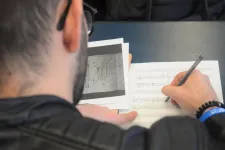(Press-News.org) Despite a name straight from a Tarantino movie, natural killer (NK) cells are your allies when it comes to fighting infections and cancer. If T cells are like a team of specialist doctors in an emergency room, NK cells are the paramedics: They arrive first on the scene and perform damage control until reinforcements arrive.
Part of our innate immune system, which dispatches these first responders, NK cells are primed from birth to recognize and respond to danger. Learning what fuels NK cells is an active area of research in immunology, with important clinical implications.
"There's a lot of interest right now in NK cells as a potential target of immunotherapy," says Joseph Sun, an immunologist in the Sloan Kettering Institute. "The more we can understand what drives these cells, the better we can program them to fight disease."
Despite a name straight from a Tarantino movie, natural killer (NK) cells are your allies when it comes to fighting infections and cancer. If T cells are like a team of specialist doctors in an emergency room, NK cells are the paramedics: They arrive first on the scene and perform damage control until reinforcements arrive.
Part of our innate immune system, which dispatches these first responders, NK cells are primed from birth to recognize and respond to danger. Learning what fuels NK cells is an active area of research in immunology, with important clinical implications.
"There's a lot of interest right now in NK cells as a potential target of immunotherapy," says Joseph Sun, an immunologist in the Sloan Kettering Institute. "The more we can understand what drives these cells, the better we can program them to fight disease."
First in Line
Previous work from researchers at MSK and elsewhere has shown that T cells rely on aerobic glycolysis to carry out their protective functions. But whether NK cells depend on this form of metabolism to power their own activities was not known.
Because Dr. Sun and his colleagues studied NK cells in animals instead of a dish, they could establish what type of metabolism NK cells use and compare it to T cells in a natural setting. They found that NK cells ramp up aerobic glycolysis about five days prior to when T cells respond with their own glycolytic surge.
"This fits with the idea that NK cells are innate immune cells that are really critical for mounting a rapid response," Dr. Sheppard says.
The findings are relevant to ongoing efforts to use NK cells as immunotherapy in people with cancer and other conditions. In particular, they have implications for using NK cells as a form of cell therapy -- when cells are grown outside a patient and then infused back into the patient's blood.
"If you're growing these cells in a dish and you push them to divide too rapidly, they may not have as much potential to undergo aerobic glycolysis when you put them into a patient," Dr. Sheppard says.
The takeaway for researchers designing clinical trials is this: They must find a balance between encouraging NK cells to multiply and preserving their stamina. These NK cells are the paramedics of our immune system, so it's important to keep them speedy and responsive.
INFORMATION:
The findings were reported June 1, 2021, in the journal Cell Reports.
This research was supported by the Cancer Research Institute, the NCI Cancer Center Support Grant (P30CA08748), Cycle for Survival, the Ludwig Center for Cancer Immunotherapy, the American Cancer Society, the Burroughs Wellcome Fund, and the NIH (grants AI100874, AI130043, AI155558). The study authors declare no conflicts of interest.
Army scientists working as part of an international consortium have developed and tested an antibody-based therapy to treat Crimean-Congo hemorrhagic fever virus (CCHFV), which is carried by ticks and kills up to 60 percent of those infected. Their results are published online today in the journal Cell.
Using blood samples donated by disease survivors, the study's authors characterized the human immune response to natural CCHFV infection. They were able to identify several potent neutralizing antibodies that target the viral glycoprotein--a component of the virus that plays a key role ...
AMES, Iowa - An unexpected discovery by an Iowa State University researcher suggests that the first humans may have arrived in North America more than 30,000 years ago - nearly 20,000 years earlier than originally thought.
Andrew Somerville, an assistant professor of anthropology in world languages and cultures, says he and his colleagues made the discovery while studying the origins of agriculture in the Tehuacan Valley in Mexico. As part of that work, they wanted to establish a date for the earliest human occupation of the Coxcatlan Cave in the valley, so they obtained radiocarbon dates for several rabbit and deer bones that were collected from the cave in the 1960s as part of the Tehuacan Archaeological-Botanical Project. The dates for the bones suddenly ...
Key takeaways
The surgical simulator can realistically simulate multiple trauma scenarios at once, compared with traditional simulators that can only simulate one or a limited number of conditions.
Trauma team members who tested the simulator preferred it for its realism, physiologic responses, and feedback.
The benefits of this innovative simulator may be able to extend to other surgical procedures and settings.
CHICAGO (June 1, 2021): Simulators have long been used for training surgeons and surgical teams, but traditional simulator platforms typically have a built-in limitation: they often simulate one or a limited ...
University of South Florida researchers recently developed a novel approach to mitigating electromigration in nanoscale electronic interconnects that are ubiquitous in state-of-the-art integrated circuits. This was achieved by coating copper metal interconnects with hexagonal boron nitride (hBN), an atomically-thin insulating two-dimensional (2D) material that shares a similar structure as the "wonder material" graphene.
Electromigration is the phenomenon in which an electrical current passing through a conductor causes the atomic-scale erosion of the material, eventually resulting in device failure. Conventional semiconductor technology addresses this challenge by using a barrier or liner material, but this takes up precious space on the wafer that could otherwise be used to pack in ...
UNIVERSITY PARK, Pa. -- In 1916 and 1917, a musician and book dealer named Giovanni Concina sold three ornately decorated seventeenth-century songbooks to a library in Venice, Italy. Now, more than 100 years later, a musicologist at Penn State has discovered that the manuscripts are fakes, meticulously crafted to appear old but actually fabricated just prior to their sale to the library. The manuscripts are rare among music forgeries in that the songs are authentic, but the books are counterfeit.
Uncovering deception was not what Marica Tacconi, professor of musicology and associate ...
A new study carried out in pig cells suggests previous infection with swine influenza virus (SIV) can protect against the development of porcine respiratory coronavirus (PRCoV) if there is a zero- or three-day interval between infections.
The findings, published in the peer-reviewed journal Virulence, may also be relevant to influenza and coronavirus infection in humans.
Ju-Yi Peng of the University of Veterinary Medicine Hannover and colleagues used air liquid interface cultures of cells taken from pigs' windpipes to investigate the interactions between the two viruses.
They found that prior infection by swine influenza virus completely inhibited coronavirus infection when the cells were infected ...
Berkeley -- Global land-use changes -- including forest fragmentation, agricultural expansion and concentrated livestock production -- are creating "hot spots" favorable for bats that carry coronaviruses and where conditions are ripe for the diseases to jump from bats to humans, finds an analysis published this week by researchers at the University of California, Berkeley, the Politecnico di Milano (Polytechnic University of Milan) and Massey University of New Zealand.
While the exact origins of the SARS-CoV-2 virus remain unclear, scientists believe that the disease likely emerged when a virus that infects horseshoe bats was able to jump to humans, either ...
Non-alcoholic fatty liver disease (NAFLD) is the most common cause of chronic liver disease worldwide. NAFLD patients are at higher risk of developing Non-alcoholic steatohepatitis (NASH), which causes severe and chronic liver inflammation, fibrosis and liver damage. A patient with NASH is believed to be at high risk for developing a form of liver cancer called hepatocellular carcinoma (HCC).
Apart from lifestyle interventions, there are currently no approved treatments for NASH. A liver transplant is sometimes the only remedy.
While risk factors for NASH (obesity, type-2 diabetes and gene mutations like PNPLA3) and HCC ...
CHAPEL HILL, North Carolina--Researchers have discovered a gene, OTUD7A, that impacts the development of Ewing sarcoma, a bone cancer that occurs mainly in children. They have also identified a compound that shows potential to block OTUD7A protein activity. The finding, by scientists at the University of North Carolina and the Lineberger Comprehensive Cancer Center, appeared online June 1, 2021, in Advanced Science.
About 250 children and young adults are diagnosed with Ewing sarcoma each year in the U.S. About half of those diagnosed will ultimately succumb to the disease, pointing to the need for better therapies.
"Our primary research focus targeted the EWS-FLI1 fusion protein found in about 85 percent of Ewing sarcoma patients," said UNC Lineberger's ...
"SWOG always brings an impressive portfolio of work to the ASCO annual meeting," said SWOG Chair Charles D. Blanke, MD, "and this year I'm particularly excited about the research our investigators are presenting because it includes results that are likely to be practice-changing."
Investigators will present 12 abstracts from SWOG-led or co-led studies and 11 abstracts from studies led by other groups within the National Clinical Trials Network (NCTN).
Results from S1216 will be presented orally by study chair Neeraj Agarwal, MD, of the Huntsman Cancer Institute at the University of Utah. S1216 compared androgen deprivation therapy (ADT) combined with TAK-700 to the standard ...



